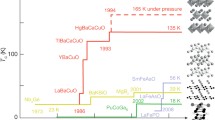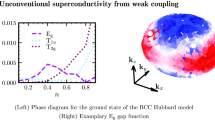Precisely what are the electrons in a high-temperature superconductor doing before they superconduct? Strong electronic correlations may give rise to composite rather than fractionalized excitations, as is typical in other strongly coupled systems such as quark matter.

Similar content being viewed by others
References
Doiron-Leyraud, N. et al. Nature 447, 565–568 (2007).
Fournier, D. et al. Nature Phys. 10.1038/nphys1763 (2010).
Norman, M. R. et al. Nature 392, 157–160 (1998).
Damascelli, A. et al. Rev. Mod. Phys. 75, 473–541 (2003).
Hertz, J. A. Phys. Rev. B 14, 1165–1184 (1976).
Phillips, P. & Chamon, C. Phys. Rev. Lett. 95, 107002 (2005).
Varma, C. M. et al. Phys. Rev. Lett. 63, 1996–1999 (1989).
Aji, V. et al. Phys. Rev. B 81, 064515 (2010).
Faulkner, T. Science 329, 1043–1047 (2010).
Chen, C. T. et al. Phys. Rev. Lett. 66, 104–107 (1991).
Meinders, M. B. J. et al. Phys. Rev. B 48, 3916–3926 (1993).
Phillips, P. Rev. Mod. Phys. 82, 1719–1742 (2010).
Leigh, R. G. et al. Phys. Rev. Lett. 77, 014512 (2008).
Anderson, P. W. J. Phys. Cond. Matt. 16, R755–R769 (2004).
Chakraborty, S. et al. Phys. Rev. B 81, 235135 (2010).
Harris, A. B. & Lange, R. V. Phys. Rev. 157, 295–314 (1967).
Lin, J. Y. et al. Preprint at http://arXiv.org/abs/1009.2560 (2010).
Vidhyadhiraja, N. S. et al. Phys. Rev. Lett. 102, 206407 (2009).
Chernyshev, A. L. et al. Phys. Rev. B 70, 235111 (2004).
Mott, N. F. Proc. Phys. Soc. Sec. A 62, 416–422 (1949).
Kohn, W. Phys. Rev. 133, A171–181 (1964).
Kaplan, T. A., Horsch, P. & Fulde, P. Phys. Rev. Lett. 49, 889–892 (1982).
Ando, Y. et al. Phys. Rev. Lett. 92, 197001 (2004).
Gor'kov, L. P. & Tietel'baum, G. B. Phys. Rev. Lett. 97, 247003 (2006).
Chakraborty, S. & Phillips, P. Phys. Rev. B 80, 132505 (2009).
Edalati, M., Leigh, R. G. & Phillips, P. Preprint at http://arXiv.org/abs/1010.3238 (2010).
Author information
Authors and Affiliations
Rights and permissions
About this article
Cite this article
Phillips, P. Fractionalize this. Nature Phys 6, 931–933 (2010). https://doi.org/10.1038/nphys1881
Published:
Issue Date:
DOI: https://doi.org/10.1038/nphys1881
- Springer Nature Limited
This article is cited by
-
Effective Interaction in a Non-Fermi Liquid Conductor and Spin Correlations in Under-Doped Cuprates
Journal of Low Temperature Physics (2018)





